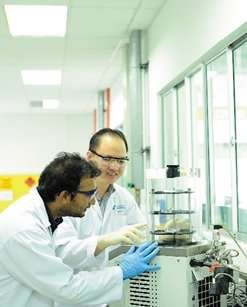Investigating retention of food nutrients during drying. Credit: University of Nottingham
In the University of Nottingham Malaysia, a team of chemical and food engineers from the Food and Pharmaceutical Engineering Research Group are investigating drying and dehydration of various food materials using advance dryers.
In food processing, drying plays a critical role in food preservation and safe consumption as most food products contain high moisture content which can deteriorate fast under room temperature. If food is not preserved properly, this could result in wastage as high as 50 percent even before reaching to the consumers. According to the Food and Agriculture Organization of the United Nations (FAO), drying is one of the most accessible and widely used processing technology which can lead to significant improvement in global food security. In view of global human population growth, there is a need to further reduce food wastage and increase the availability of food and drying is one of the viable techniques that we should revisit.
In the University of Nottingham Malaysia, a team of chemical and food engineers from the Food and Pharmaceutical Engineering Research Group are investigating drying and dehydration of various food materials using advance dryers. The drying characteristics and quality of various products have been investigated, namely of kedondong, salak, chempedak, ciku, starfruit, birdnest, ancient Chinese mushroom lingzhi, roselle, herbal Asian tea - java tea, moringa, Sabah snake grass, cocoa, papaya leaf, chicken meat, paddy and rice noodle. Significant improvement in nutrient and antioxidant retentions are achievable when these products are dried under low/mild drying conditions. For example, retention of bioactive ingredients in the range of 78 percent to 97 percent was observed in birdnest dried below 40°C using dehumidified air.
In addition to that, the research team has also developed and tested advance dryers such as heat pump dryer, adsorption dryer, intermittent dryer, infrared dryer, solar dryer and microwave dryer. Development of these dryers aims to improve the drying rates and efficiency of drying. Drying is an energy intensive operation and could account for up to 15 percent of all industrial energy usage. Fortunately, taking the heat pump dryer as an example, a two-fold increase in drying efficiency could be attained as compared to conventional drying using hot air.
In product development, current research areas focus on the development of healthy fruit snacks from underutilised fruits. Completed studies have successfully developed dried fruit snacks from Malaysian fruits salak, chempedak and ciku while research on kedondong is currently on-going. Future studies include the processing of alternative protein sources from edible insects such as mealworm. Consumption of edible insects could help to meet the demand for food protein and also as an environmental friendly option of future food.
More information: Thing Chai Tham et al. Effect of ambient conditions on drying of herbs in solar greenhouse dryer with integrated heat pump, Drying Technology (2017). DOI: 10.1080/07373937.2016.1271984
Shu Hui Gan et al. Kinetic retention of sialic acid and antioxidants in Malaysian edible bird's nest during low-temperature drying, Drying Technology (2016). DOI: 10.1080/07373937.2016.1219741
A. Santhanam Menon et al. Effects of drying on the production of polyphenol-rich cocoa beans, Drying Technology (2017). DOI: 10.1080/07373937.2016.1276072
Provided by University of Nottingham























